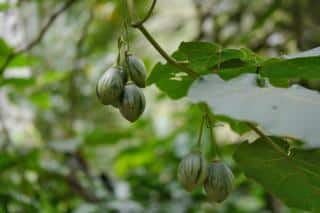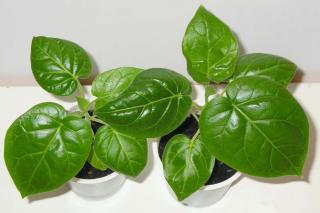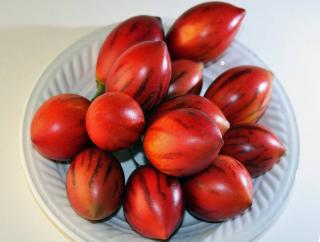

The tamarillo is a fruit shrub native to the tropics which bears surprising fruits with firm flesh and a tangy, pungent taste.
Top Tamarillo facts
Name – Solanum betacea (formerly Cyphomandra betacea)
Family – Solanaceae or nightshade
Type – fruit tree
Height – 3 to 13 feet (1 to 4 m) (in its natural environment)
Exposure – full sun or well-lit when indoors
Soil – light, rich enough
Harvest – summer, let it ripen on the plant
Its similarity to tomatoes gave it the common name tomato tree. Here is how to grow it at home.
 Under our temperate latitudes, the tamarillo tree is grown outdoors only in areas where the climate is mild in winter, because leaves fall off at 28°F (-2°C) and the shrub dies if temperatures drop below 26°F (-3°C).
Under our temperate latitudes, the tamarillo tree is grown outdoors only in areas where the climate is mild in winter, because leaves fall off at 28°F (-2°C) and the shrub dies if temperatures drop below 26°F (-3°C).
It can thus be grown along the Atlantic and Pacific coasts, around the Mediterranean, if the growing conditions are carefully monitored and protective winter covering is provided.
Tamarillo is a heavy feeder that will quickly drain the surrounding area from its initial nutrients. Ideally, you would fertilize at three key moments:
A balanced fertilizer is fine, with an NPK ratio that has the same number for each element. This will help the entire tree thrive from root to fruit. For example, a 10:10:10 or a 5:5:5 fertilizer will do well. For these, follow the dosage recommended on the labels.
An even better option is to add organic fertilizer to the soil around the tree:
Organic fertilizers can be applied anytime, except for the colder months of winter when plants are dormant. See each article for the proper doses.
If you fear that temperatures fall below freezing in winter, you don’t have a choice but to grow your tamarillo tree in a pot so that you can protect it over the winter.
 It doesn’t resist freezing, so tamarillo must be grown as if it were citrus, bringing it in a greenhouse over winter, being a cooler place that is protected from frost.
It doesn’t resist freezing, so tamarillo must be grown as if it were citrus, bringing it in a greenhouse over winter, being a cooler place that is protected from frost.
If you choose to grow tamarillo trees indoors all year round, you’ll have to organize their dormancy at some point during the winter.
Tamarillo is a fruit tree that loves receiving a lot of water in summer, especially in case of high temperatures.
Daily watering is recommended if ever a dry spell or heat wave hits.
Apart from watering, it is relatively easy to care for tamarillo in winter and in summer.
 Tamarillo is best harvested quite ripe, as close to complete maturity as is possible. It should be eaten quickly after the harvest, while still very fresh.
Tamarillo is best harvested quite ripe, as close to complete maturity as is possible. It should be eaten quickly after the harvest, while still very fresh.
If not yet mature, it doesn’t taste so good, and if too young it even becomes difficult to digest.
If the fruits aren’t ripe enough upon harvest, you can let them ripen just like regular tomatoes before eating them.
Tamarillo is native to Peru and is well-known thanks to its red or orange fruit.
It belongs to the same family as regular tomatoes, Solanaceae, but its fruits look more like plums.
Tomato tree fruits are slightly tangy and their firm, meaty flesh can be eaten in the same manner as tomatoes are, though raw their taste is of the love-it-or-hate-it kind.
This fruit is also often savored juiced, and another name for it is tomato tree. Cooking it (or smoking it, even) will take the edge off of the fruit and it is excellent when minced into thick sauces where it balances other spices out.
The world’s largest producer is Columbia, in South America, which explains why this fruit tree has trouble growing out doors in more temperate climates.
To grow it outdoors, try to find the Cyphomandra corymbiflora variety because it is hardy down to 19°F (-7°C), if in full sun and sheltered from wind.
Feed tamarilloes regularly, what does that mean? How much per sq meter, when? what NPK?
Hi Chris, thanks for your comment – I added a section in the article about how to fertilize the tamarillo tree, I hope it helps.
can I prune my Tamarillo ? I have it in a pot & its getting very tall & ,it grows rapidly, only 1 branch off it, I was thinking of planting it in the garden, but not sure about the root system ,don’t want anything that can cause a problem later, we live in Queensland Australia, so not cool weather problem, thank you, hoping you can help me
My Tomatillo, growing in a pot, has both black fly and green fly on the back of the leaves. I have removed them by hand with a soft paper towel. What organic remedies could you recommend to get rid of the flies? Removing them by hand was fine as the plant is still quite small, but could be a problem as it gets taller. Any other advice would be gratefully received. I live in the southern hemisphere, so am heading towards summer, which can be very hot and wet here.
Hello Hazell, unless you send me a picture to prove me wrong, greenfly and blackfly are actually two species of aphids. You can find a lot of different organic tips to control aphids here. It’s just the right time to look into it, too! With every passing fortnight, populations can double this season in your part of the world.
Hi
I have a one year old Tamarillo in a pot. The large bottom leaves turned yellow and dropped off and Incan see that this is happening gradually up the stem. Where the leaves have dropped off I can see new leaves appearing. Is this normal? Also, the tree has started to branch at the top, do I need to provide some sort of support for these branches as with the heavy leaves I am concerned that they will break.
Thanks
Hi, it’s part of the growing cycle to replace older leaves with fresh ones higher up, so your intuition was correct. You can extend the life of lower leaves a bit by increasing moisture around the plant, especially if growing indoors.
Normally the branches will strengthen as the leaves grow larger, so you needn’t worry about staking them. In the summer, you can bring it outdoors a bit or on a balcony so that it can experience wind. Wind also strengthens branches and stems. Do this progressively though: 1 hour/day for 3-4 days, then 2 hours/day for 3-4 days, then half a day for a week and then you’re good to leave it out if it doesn’t get too cold at night.
I have been growing Tamarillo (tomate de árbol) for several years. I sometimes have unexpected and unexplained die off which is probably due to the clay soil of the East SF Bay Area where I live that doesn’t drain well. Thanks for the information about root rot. Tamarillos are not common in Peru however. They are more common in Ecuador and Colombia. Most Peruvians I know have never heard of them.
Hi Tom! That’s very true and actually today’s countries don’t really reflect the areas that were under the rule of this or that civilization at the time. I believe it was a food that the Inca spread as they conquered different parts of Central and South America. Today, most fruits sold across the world come from strains cultivated in Australia and other warm countries. Thanks a lot for your comment!